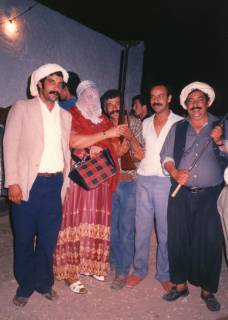Oran, Sidi Bel-Abbes, Mascara, Ghelizane, Ain Temouchent, and Saida are birthplaces, adopted cities, or cultural heritage sites for the sheikhat. A sheikha does not bear her family name; she sheds it upon entering the public domain and crossing the limits of the horma. She is called by a given name, sometimes followed by a nickname and/or the place where she works: Rahma el Abassya (Rahma of Belabas), Hab Lahmeur (the red buttons), Keltoum el Balini, (Keltoum of the Balini [quarter]), Habiba el Kebira (Habiba the elder), Habiba Sghira (Habiba the younger), Rimitti el Ghelizanya (Rimitti of Ghelizane), etc. For the purpose of clarity, 'particles' are added in order not to confuse sheikha Djinya el Kebira el Haqqanya bent Saida (Djinya the elder, the true daughter of Saida) with sheikha Djinya el Mascarya (Djinya of Mascar).
All these episodes appear as elusive traces in the songs. Everyone can find in them something that can be related to one's own distress and, under the paroxysm, to tendencies in daily life. The world of the meddahat [female singers in honor of the Prophet and the Saints] is less turbulent. The fact that they sing in the feminine milieu shields them from certain charges. But this job, occupied only by women most often without husbands or male protectors, does not allow for the cultural recognition that would protect them from obscurity. Their earnings, concentrated around the season of marriages and the evenings of Ramadan, are precarious. Moreover, competition between and inside groups is intense. The financial obligations and psychological pressures on the meallma, the group's leader, are often very strong.
Meddahat during a wedding performing a 1980s hit
celebrating women's liberation: A duo performing the same song: |

